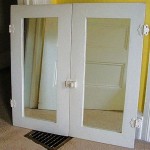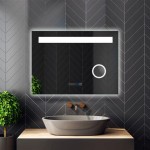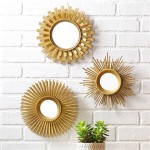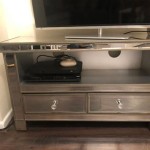How To Hang A Large Mirror Without Wall Damage
Hanging a large mirror can significantly enhance a room's aesthetic appeal, but the process requires careful consideration to avoid unnecessary wall damage. This article offers a comprehensive guide for achieving a secure and damage-free hanging experience.
Assessing the Mirror and Wall
Before initiating the hanging process, a thorough evaluation of both the mirror and the intended wall is crucial. This assessment informs the choice of hanging method and necessary hardware.
Key Considerations:
- Mirror Weight: Heavier mirrors necessitate stronger hanging mechanisms.
- Mirror Backing: The type of backing influences the chosen hanging hardware.
- Wall Type: Different wall materials (drywall, plaster, concrete) require specific fasteners.
- Wall Studs: Locating studs provides the most secure anchor points.
Choosing the Right Hanging Hardware
Selecting appropriate hardware ensures the mirror's stability and minimizes wall damage. The mirror’s weight and the wall type are primary factors influencing this choice.
Key Hardware Options:
- Heavy-Duty Mirror Clips: Ideal for heavier mirrors, offering secure gripping power.
- D-Rings and Wire: A common method for medium-weight mirrors, allowing for adjustable leveling.
- Adhesive Hooks: Suitable for lighter mirrors on smooth surfaces, offering a damage-free option.
- French Cleats: Distribute weight evenly and provide a robust hold for large, heavy mirrors.
Utilizing Damage-Free Hanging Methods
Several techniques minimize or eliminate wall damage during the hanging process. These methods are particularly beneficial for renters or those who frequently redecorate.
Key Damage-Free Methods:
- Command Strips: These adhesive strips support lighter mirrors and are easily removable.
- Hardwall Hangers: Designed for plaster or concrete walls, these hangers minimize the need for large holes.
- Mirror Mounting Tape: Double-sided tape specifically formulated for mirrors offers a no-holes hanging solution.
Locating Wall Studs
Hanging heavy mirrors on wall studs provides the most secure support. A stud finder is a valuable tool for accurately locating these structural supports behind the wall.
Key Stud Finding Techniques:
- Electronic Stud Finders: These devices utilize electronic sensors to pinpoint stud locations.
- Magnetic Stud Finders: Detect nails or screws within the stud, indicating its position.
- Tapping Method: Gently tapping the wall and listening for a change in sound (from hollow to solid) can help locate studs.
Preparing the Mirror for Hanging
Proper preparation of the mirror ensures a smooth and efficient hanging process.
Key Preparation Steps:
- Clean the Mirror Backing: Ensure the surface is clean and free of debris for optimal adhesion.
- Attach Hanging Hardware: Securely attach D-rings, wire, or cleats according to the chosen method.
- Measure and Mark: Accurately measure and mark the desired hanging location on the wall.
Installing the Hanging Hardware on the Wall
Correct installation of wall anchors or screws is crucial for the mirror’s stability and safety.
Key Installation Tips:
- Use Appropriate Fasteners: Select anchors and screws suitable for the wall type and mirror weight.
- Pre-Drill Pilot Holes: This prevents wall cracking and ensures secure anchoring.
- Use a Level: Ensure the anchors or screws are installed perfectly level.
Hanging the Mirror and Final Adjustments
The final steps involve carefully hanging the mirror and making any necessary adjustments for perfect placement.
Key Hanging and Adjustment Tips:
- Enlist Assistance: For larger mirrors, having another person assist with lifting and positioning is recommended.
- Check for Stability: Once hung, gently test the mirror's stability to ensure it is securely mounted.
- Adjust and Level: Use shims or adjustable hardware to achieve perfect leveling and alignment.
Maintaining the Mirror and Hanging Hardware
Regular maintenance ensures the mirror remains securely hung and in optimal condition.
Key Maintenance Practices:
- Periodically Check Hardware: Inspect the hanging hardware for signs of wear or loosening.
- Clean the Mirror: Regularly clean the mirror surface with appropriate glass cleaner.
- Re-Tighten Fasteners: If necessary, re-tighten any loose screws or anchors.

3 Simple Ways To Hang A Mirror On Wall Without Nails Wikihow

How To Hang A Heavy Mirror Without Nails 4 Alternative Ways Homelyville
How To Hang A Heavy Mirror On Drywall Without Damaging It Or The Wall Quora

3 Simple Ways To Hang A Mirror On Wall Without Nails Wikihow

How To Put Mirrors On Walls Without Nails

Hang Mirror Without Nail Or

3 Simple Ways To Hang A Mirror On Wall Without Nails Wikihow

3 Simple Ways To Hang A Mirror On Wall Without Nails Wikihow

How To Hang A Heavy Mirror Diy Family Handyman

Tip How To Hang Something Heavy With Minimal Wall Damage Home Stories A Z








